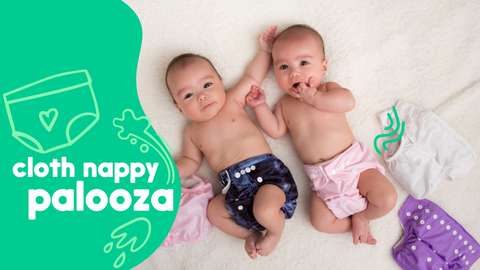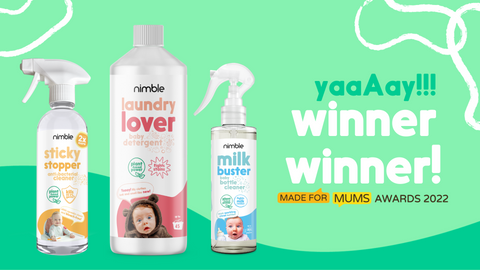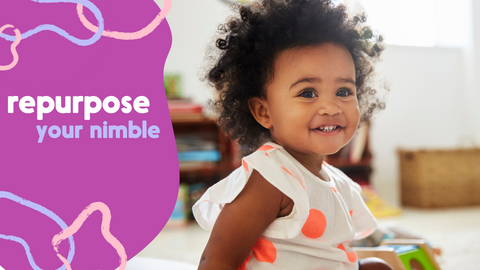It's reusable nappy week, so we thought we'd share a quick guide on the different types of cloth nappies, plus some hints and tips to get them sparkly clean- even after the odd poonami! Read on to find out all you need to know about the different types of reusable nappies and how to care for them!
All-in-One
All-in-One nappies are all parts of the reusable nappy in one piece: a waterproof part and an absorbent part, permanently attached. The design of all-in-one nappies can vary depending on the brand, as some will have absorbent bits sewn in, and others will have a pocket to tuck the tongue into, which we'll talk about next.
Pocket nappies
Pocket nappies are a type of all-in-one nappy, but these have a waterproof pocket and an absorbent insert that fits inside of it. This pocket will usually have a microfleece lining, and the whole nappy will need to be changed once it's wet.
All-in-Two
Unlike the all-in-one, the all-in-two nappy is made up of - you guessed it - two parts. The cover is waterproof and the absorbent insert attaches to it usually via poppers. Although these are two separate parts, they are designed to work together. Most all-in-two nappy covers are designed to be wiped clean and used three or four times before washing - so all you need to do is replace the inserts! But do be aware that not all-in-twos have a waterproof wipe-clean cover, which means they may need to be replaced with every nappy change.
For all-in-two reusable nappies we love the Cheeky DooDoo Reusable Bamboo Cloth Nappies by Cheeky Wipes. They've designed their 2-part nappies to be slim fitting and poonami-proof, even at night time. What more could you want?
Fitted nappies
Fitted nappies are made from a completely absorbent material, which means that you need a separate waterproof cover to go over the top. You can reuse this cover three or four times if it is not dirty.Flat nappies
Flat nappies are a more traditional way to use reusable nappies, but they are no less popular today. Flat nappies are either terry cloth, muslin or pre-folds— the latter can simply be folded, rather than fastened, and placed inside a cover. They're made from flat pieces of absorbent material folded and secured with a nappy fastener or safety pins.Which nappy type is best for me?
From this list, you might know which nappy type is best for you and your baby- and that's great! But if you're not sure, you can always try a few to see which work best. Find out if there is a nappy library local to you where you can hire a trial kit, or look online to find a retailer that will loan you a few to try.Generally speaking, it's a good idea to try a few different types before you invest, or you could end up forking out for a bundle of nappies that you won't use. We've listed some of the features of each type below to help you out:
All-in-One
-
Easy to use
-
Good for childcare settings, as they are very similar in design to disposable nappies
-
Can be slim fitting
-
Often dry more slowly as the absorbent part cannot be detached from the waterproof cover
-
Tend to be more expensive
-
Usually need extra inserts to act as a booster for overnight
Pocket Nappies
-
Easy to use, but inserts need removing before washing and put back again before use
-
Quick to dry after washing
-
Affordable option
-
Good for childcare
-
Tend to be a little bulky under clothes
All-in-Two
-
Easy to use
-
Can be used overnight, with the correct inserts
-
Can be pre-stuffed if sent to childcare for easy use
-
Quicker to dry after washing
-
More affordable
-
Can be slim fitting
-
Covers can sometimes be used with other nappies
Fitted Nappies
-
Easy to use once you're used to them- but folding and fastening takes some practise
-
Quick to dry
-
Generally affordable, but you do need to buy separate covers
-
Tend to be bulky under clothes
-
May need to buy different sizes as baby grows
-
Great for overnight
Caring for your reusable nappies
We know about laundry, if we know anything, here at Nimble HQ! And we're guessing that knowing how to clean your reusable nappies is something you're pretty keen to learn. Here are our top tips:
-
Pre-wash new nappies before first use (wondering why? Click here)
-
Wash cloth nappies with a detergent specifically made for them! We recommend Nappy Lover Cloth Nappy Detergent
-
Place solids into the toilet and flush away. Rinse covers and inserts under the tap to dilute residue
-
Unsnap poppers
-
Store nappies in a dry pail between washes- no longer than 2-3 days!
-
Short wash- For a 3/4 load, wash with half a capful of Nappy Lover
-
Main wash- With a 3/4 load, wash with a full capful of Nappy Lover
-
No need to use fabric softeners for cloth nappies
-
Run a lengthy cycle at 40-60 degrees, and add the detergent straight into the drum
-
Waterproof covers should be washed at 40 degrees— no higher
-
Air dry, or add to a low tumble dryer
-
No need to soak or bleach

Let us know if you have any questions, comments or tips!










